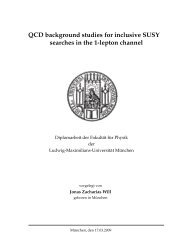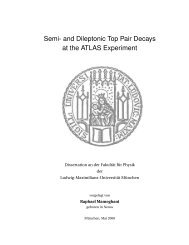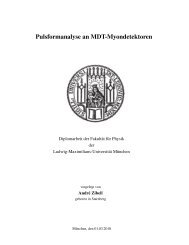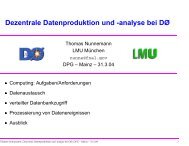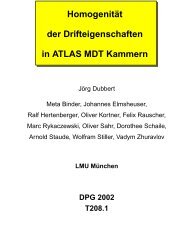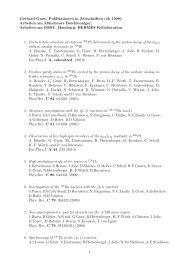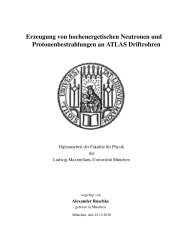development of micro-pattern gaseous detectors – gem - LMU
development of micro-pattern gaseous detectors – gem - LMU
development of micro-pattern gaseous detectors – gem - LMU
Create successful ePaper yourself
Turn your PDF publications into a flip-book with our unique Google optimized e-Paper software.
Chapter 6<br />
Rise Time Studies<br />
For a better understanding <strong>of</strong> the signal creation in the GEM detector the rise time was studied<br />
in dependence on the operational parameters. This chapter starts with the time resolution <strong>of</strong> the<br />
prototype 1.0 and shows afterwards measurements done for electric field variations in the gap regions.<br />
6.1 Time Resolution<br />
The rise time can be determined via the inverse Fermi fit to the rising edge <strong>of</strong> the signal (10% − 90%<br />
<strong>of</strong> the pulse maximum), as presented in Ch. 3.5. For investigation <strong>of</strong> the time resolution <strong>of</strong> the<br />
detector a localized primary charge distribution in the drift region is necessary. This includes<br />
analization <strong>of</strong> the electronics response using a temporarly defined pulse. For this analysis the charges<br />
generated by X-rays from the 55 Fe source can be used. Since the primary produced photoelectron<br />
loses its energy due to ionization <strong>of</strong> further atoms in a small range we can approximate the pulse as<br />
punctual in time and location. Fig. 6.1 and Fig. 6.3 show that such a point-like distributed charge<br />
generates a rise time <strong>of</strong> approximately 166 ns and 102 ns for signals recorded via the preamplifiers<br />
CATSA82 and ELab, respectively. The Gaussian fits to the histogram <strong>of</strong> 55 Fe measurements present<br />
therefore good resolution, in addition as the detector is self-triggering. A resolution <strong>of</strong> these rise<br />
times as sharp as 7% and 2% for the CATSA82 and ELab preamplifier, respectively, is thus given by<br />
default.<br />
The cosmic ray muons, instead, produce electron-ion-pairs along their track while traversing the<br />
detector. Thus the charge produced by muons that is responsible for the signal creation is distributed<br />
over the whole drift region. The time between the first charges reaching the anode and the last depends<br />
on the drift velocity and the size <strong>of</strong> the drift gap.<br />
Fig. 6.2 and 6.4 show the time resolution <strong>of</strong> exemplary data samples <strong>of</strong> cosmics recorded with the<br />
CATSA82 as well as the ELab preamplifier. The rise time resolution is 26% and 20% for the individual<br />
preamplifiers.<br />
The drift velocity <strong>of</strong> the electrons was determined by a GARFIELD/MAGBOLTZ simulation. In<br />
this simulation a parallel plate field is assumed ignoring the field configurations near the GEM<br />
foils (see Fig. 6.5). The program calculates the drift velocity in a given gas mixture, pressure and<br />
temperature for the indicated geometries. This results, for instance, in a drift time for electrons from<br />
the upper end <strong>of</strong> the drift region to the uppermost GEM foil <strong>of</strong> tdri ft = 99.5 ns for a electric field <strong>of</strong><br />
Edri ft = 1.25 kV/cm, as it is drawn in Fig. 6.6.<br />
65



